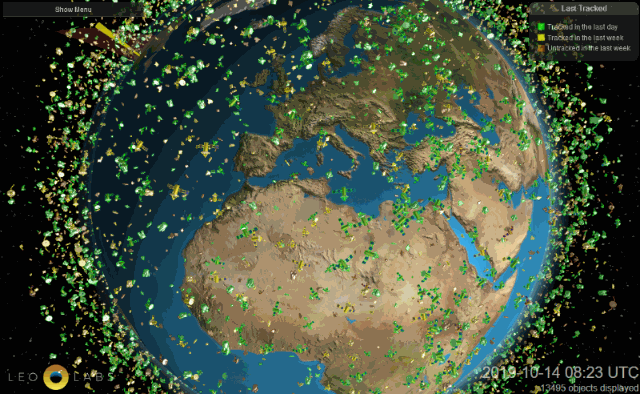- My Forums
- Tiger Rant
- LSU Recruiting
- SEC Rant
- Saints Talk
- Pelicans Talk
- More Sports Board
- Coaching Changes
- Fantasy Sports
- Golf Board
- Soccer Board
- O-T Lounge
- Tech Board
- Home/Garden Board
- Outdoor Board
- Health/Fitness Board
- Movie/TV Board
- Book Board
- Music Board
- Political Talk
- Money Talk
- Fark Board
- Gaming Board
- Travel Board
- Food/Drink Board
- Ticket Exchange
- TD Help Board
Customize My Forums- View All Forums
- Show Left Links
- Topic Sort Options
- Trending Topics
- Recent Topics
- Active Topics
Started By
Message
LeoLabs reminds us the sky is far from “empty” You can track everything currently in orbit
Posted on 11/5/25 at 9:49 pm
Posted on 11/5/25 at 9:49 pm
Posted on 11/5/25 at 9:57 pm to DustyDinkleman
In actuality, if you were in space looking at the Earth from that distance you wouldn't see any of that, but if you were trying to enter Earth's atmosphere, you damn well better know where it all is or risk a satellite or small particle blowing a hole through your entry vehicle.
Posted on 11/5/25 at 10:17 pm to DustyDinkleman
I was thinking like,
10-15 satellite thingy’s.
10-15 satellite thingy’s.
Posted on 11/5/25 at 10:24 pm to DustyDinkleman
It’s pretty amazing going somewhere out west with no light pollution. You see a ton of satellites.
Posted on 11/5/25 at 10:41 pm to DustyDinkleman
Keep in mind though the icons are far from scale. There’s a lot up there numerically but not as much space wise.
Posted on 11/5/25 at 10:52 pm to DustyDinkleman
Scale is pretty important. This image makes it seem like something entering the atmosphere would be lucky NOT to hit something on the way in.
In reality, the incoming object would have a much higher chance of winning the lottery than hitting a piece of space junk on the way in.
In reality, the incoming object would have a much higher chance of winning the lottery than hitting a piece of space junk on the way in.
Posted on 11/5/25 at 11:27 pm to DustyDinkleman
Well on our way to Wall-E.
Posted on 11/5/25 at 11:41 pm to DustyDinkleman
And that'd not even all the uaps
Posted on 11/5/25 at 11:55 pm to DustyDinkleman
Looks like a cell infected with cancer
Posted on 11/6/25 at 12:02 am to FahQGump
quote:
Looks like a cell infected with cancer
That’s because it is
Posted on 11/6/25 at 6:26 am to DustyDinkleman
It also doesn’t show distance from Earth. Some are 40k miles out, some are 24k out, some 100 miles
Vanguard 1 has been in orbit since 1958.
Vanguard 1 has been in orbit since 1958.
This post was edited on 11/6/25 at 6:29 am
Posted on 11/6/25 at 8:20 am to DustyDinkleman
Posted on 11/6/25 at 8:37 am to DustyDinkleman
Imagine that we find another planet somewhere in the galaxy with all this going on
Posted on 11/6/25 at 8:55 am to DustyDinkleman
That’s what i’ve been saying. There’s nothing regulating what gets shot up into orbit. How long before anything NASA or SpaceX or whoever tries to do gets foiled by the massive amount of junk up there? How long before flaming space metal starts falling out of the sky and landing on things?
Posted on 11/6/25 at 9:50 am to DustyDinkleman
straight out of wal-e



Posted on 11/6/25 at 9:53 am to DustyDinkleman
On a clear night even with all of the lights in SoCal we can see the ISS cruise by.
It's pretty bright and very easy to spot.
It's pretty bright and very easy to spot.
Posted on 11/6/25 at 10:26 am to HubbaBubba
quote:
In actuality, if you were in space looking at the Earth from that distance you wouldn't see any of that, but if you were trying to enter Earth's atmosphere, you damn well better know where it all is or risk a satellite or small particle blowing a hole through your entry vehicle.
Do ICBM's travel below that?
Posted on 11/6/25 at 10:31 am to DustyDinkleman
quote:
The Kessler syndrome, also known as the Kessler effect, collisional cascading, or ablation cascade, is a scenario proposed by NASA scientists Donald J. Kessler and Burton G. Cour-Palais in 1978. It describes a situation in which the density of objects in low Earth orbit (LEO) becomes so high due to space pollution that collisions between these objects cascade, exponentially increasing the amount of space debris over time. This proliferation of debris poses significant risks to satellites, space missions, and the International Space Station, potentially rendering certain orbital regions unusable and threatening the sustainability of space activities for many generations.
LINK
Posted on 11/6/25 at 10:39 am to Rick9Plus
quote:
That’s what i’ve been saying. There’s nothing regulating what gets shot up into orbit. How long before anything NASA or SpaceX or whoever tries to do gets foiled by the massive amount of junk up there? How long before flaming space metal starts falling out of the sky and landing on things?
The problem is self-correcting. All orbits decay, and very, very little of what's up there won't burn up completely before it hits the ground. What does make it has worse-than-lottery odds of hitting something meaningful. The earth is a giant recycling machine.
And yes, there are regs and launch permits worldwide on what goes up there. Some, like China and India, are more lax than others. At some point, we may have to put up some "street cleaning" satellites that de-orbit junk by pushing it in some manner, but we're still a ways from that. No one reading this will see a "Wall-E" scenario in their lifetimes.
Posted on 11/6/25 at 12:36 pm to lowhound
quote:@grok
Do ICBM's travel below that?
Popular
Back to top


 15
15













